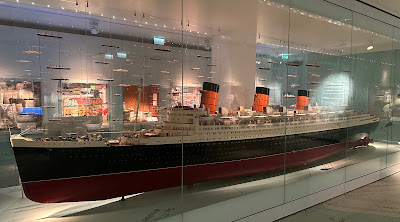One thing I learned from my visit to the SeaCity Museum in Southampton is that I love looking at model ships in glass cases. With the museum comprising of three major sections, telling the story of the RMS Titanic and its fateful maiden voyage from Southampton in 1912, the story of Southampton as a major seafaring port, and a rotating display of items from the city council’s archives, at every point no opportunity is lost to display a model of a ship in a glass case. From the 1:25 scale model of RMS Queen Mary, reproduced to a terrifying level of detail by the same shipyard that built the full-size ship, to the latest of the Lego “Titanic” models, this is the closest I can get to experiencing the glamour and opulence of transatlantic travel.
It's odd wanting to travel on something that no longer exists – I sincerely doubt the Queen Mary could move from its spot in Long Beach, California after fifty years, and the SS United States, gutted of its insides and facing an uncertain future in Philadelphia has been out of service for just as long. No-one has reason to build ocean liners of their type, with only Cunard’s Queen Mary 2 maintaining a transatlantic route for only part of the year, its status as a Royal Mail Steamer (RMS) being a ceremonial gesture to the old days of “steam packet” routes across the world. Passenger jets rendered obsolete the ships built to withstand the punishment of the Atlantic Ocean, and ill-equipped to be adapted for cruising, where the ship itself became the destination – only the bottom half of the Queen Mary 2 is built like an ocean liner of old, its superstructure being a modern cruise ship.
Cruise ships have changed the expectations of ocean-going passengers – my parents have visited the Queen Mary in California, and were amazed by how small it felt, particularly the cabins. The ships I would have liked the opportunity to travel on, an idea of “wouldn’t it be nice” tempered by thoughts of “it won’t sell these days”, were Cunard’s RMS Media and RMS Parthia. Half the length of the Queen Mary, they operated from Liverpool to New York, transporting a maximum of 250 passengers, all in first class, plus freight. They were Katharine Hepburn’s favourite transatlantic ships, and their more contained and relaxed nature makes it easy to see why. Apart from two decks of cabins, the common rooms were contained on one deck featuring a lounge, drawing room, smoking room, cocktail bar, a long gallery and promenade, library, dining room and barber shop. No swimming pool, no rollercoaster, no climbing wall, only opportunities to relax, sit and chat. Both jet travel and cargo ships would curtail the Media and Parthia’s careers with Cunard in 1961, sold to be refitted as cruise liners carrying substantially more passengers.




No comments:
Post a Comment